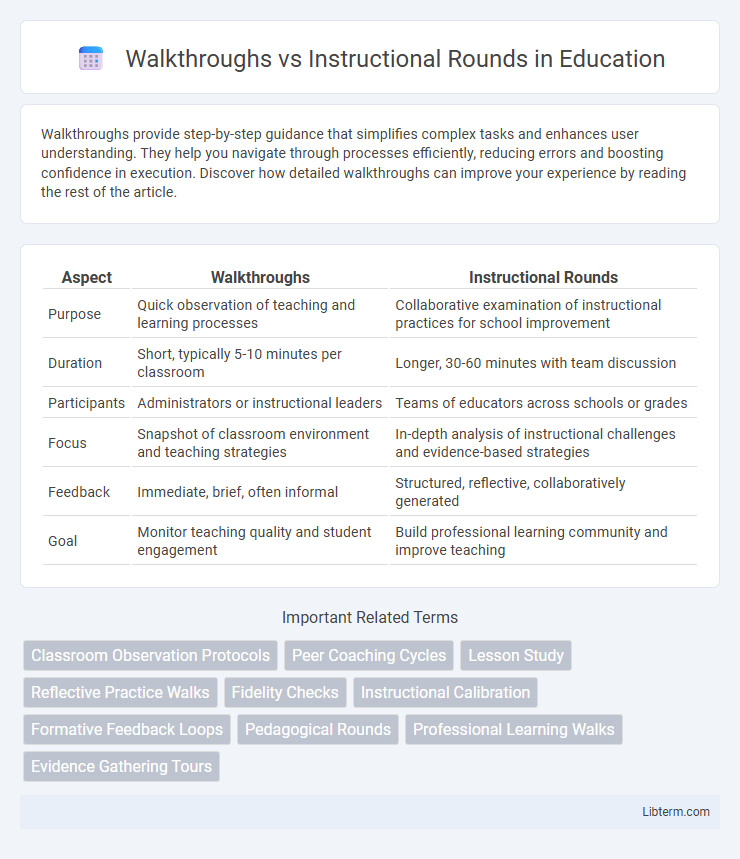Walkthroughs provide step-by-step guidance that simplifies complex tasks and enhances user understanding. They help you navigate through processes efficiently, reducing errors and boosting confidence in execution. Discover how detailed walkthroughs can improve your experience by reading the rest of the article.
Table of Comparison
| Aspect | Walkthroughs | Instructional Rounds |
|---|---|---|
| Purpose | Quick observation of teaching and learning processes | Collaborative examination of instructional practices for school improvement |
| Duration | Short, typically 5-10 minutes per classroom | Longer, 30-60 minutes with team discussion |
| Participants | Administrators or instructional leaders | Teams of educators across schools or grades |
| Focus | Snapshot of classroom environment and teaching strategies | In-depth analysis of instructional challenges and evidence-based strategies |
| Feedback | Immediate, brief, often informal | Structured, reflective, collaboratively generated |
| Goal | Monitor teaching quality and student engagement | Build professional learning community and improve teaching |
Understanding Walkthroughs and Instructional Rounds
Walkthroughs involve brief, focused observations by administrators or instructional coaches to gather data on teaching practices and student engagement, enabling immediate feedback and targeted support. Instructional Rounds consist of collaborative, structured visits by groups of educators aimed at diagnosing instructional challenges and sharing best practices across classrooms. Both methods prioritize continuous improvement but differ in scope, frequency, and collaborative depth, with walkthroughs offering rapid insights and instructional rounds emphasizing in-depth analysis and collective professional learning.
Core Purposes: Walkthroughs vs Instructional Rounds
Walkthroughs primarily focus on observing teaching practices and student engagement to gather real-time data for immediate feedback and professional development. Instructional Rounds emphasize collaborative, reflective discussions among educators aimed at improving instructional strategies and student learning outcomes over time. Both practices center on continuous improvement but differ in scope, with Walkthroughs targeting quick insights and Instructional Rounds fostering deeper systemic change.
Key Features and Processes
Walkthroughs involve brief, focused observations where leaders collect data on teaching practices, student engagement, and learning environments to provide immediate feedback. Instructional Rounds consist of collaborative groups of educators who systematically observe classrooms, analyze practices, and identify trends to improve instructional quality across schools. While walkthroughs emphasize quick snapshots and individual feedback, instructional rounds prioritize collective inquiry and school-wide instructional improvement.
Roles and Responsibilities
Walkthroughs involve school leaders and teachers collaboratively observing classrooms to gather immediate feedback on teaching practices, with a focus on instructional improvement and student engagement. Instructional Rounds engage a broader team of educators and administrators who systematically visit multiple classrooms to identify patterns and challenges in curriculum delivery, emphasizing collective problem-solving and long-term strategy development. Both processes require clear roles where observers act as non-evaluative participants committed to supporting teacher growth and fostering a culture of continuous professional development.
Frequency and Scheduling
Walkthroughs typically occur weekly or biweekly, targeting informal observations to quickly assess classroom engagement and instructional practices. Instructional Rounds are scheduled less frequently, often monthly or quarterly, designed to facilitate collaborative analysis and deeper reflection among educators. Efficient scheduling balances consistent data collection from Walkthroughs with periodic, comprehensive insights gained through Instructional Rounds.
Data Collection Methods
Walkthroughs involve brief, focused observations primarily capturing real-time instructional practices and student engagement through checklists or quick notes. Instructional Rounds use systematic data collection methods including detailed observation protocols and collaborative data analysis to identify patterns and instructional improvement areas. Both methods prioritize evidence-based insights but differ in scope and depth of data gathered for school-wide teaching enhancements.
Impact on Teaching and Learning
Walkthroughs provide quick, informal observations that offer immediate feedback to teachers, fostering real-time adjustments and promoting reflective teaching practices. Instructional rounds involve collaborative, structured observations by teams focused on improving student learning through shared analysis of instructional strategies and outcomes. Both approaches enhance teaching quality by identifying strengths and areas for growth, but instructional rounds have a stronger emphasis on sustained, collective professional development and school-wide instructional coherence.
Benefits and Limitations
Walkthroughs offer quick, informal observations that provide immediate feedback on classroom practices, fostering rapid improvements and promoting a culture of continuous learning. Instructional rounds involve collaborative, structured observations across multiple classrooms to identify systemic instructional challenges and develop shared solutions, enhancing overall school performance. While walkthroughs may lack depth and can lead to superficial evaluations, instructional rounds require significant time and coordination, which can limit their frequency and scalability.
Best Practices for Implementation
Effective implementation of Walkthroughs involves clear objectives, consistent scheduling, and collaborative data sharing among educators to drive instructional improvements. Instructional Rounds require structured protocols, focused observation on specific teaching practices, and reflective team discussions to refine classroom strategies. Both methodologies benefit from leadership support, ongoing professional development, and alignment with school improvement goals to maximize impact on student learning.
Selecting the Right Approach for Your School
Choosing between walkthroughs and instructional rounds depends largely on the specific goals and culture of your school. Walkthroughs are ideal for quick, formative observations to monitor classroom practices and provide immediate feedback, while instructional rounds emphasize collaborative analysis of teaching strategies and student learning over time. Schools aiming for ongoing professional development and deeper instructional improvement benefit more from instructional rounds, whereas walkthroughs suit environments needing rapid, targeted insights.
Walkthroughs Infographic

 libterm.com
libterm.com